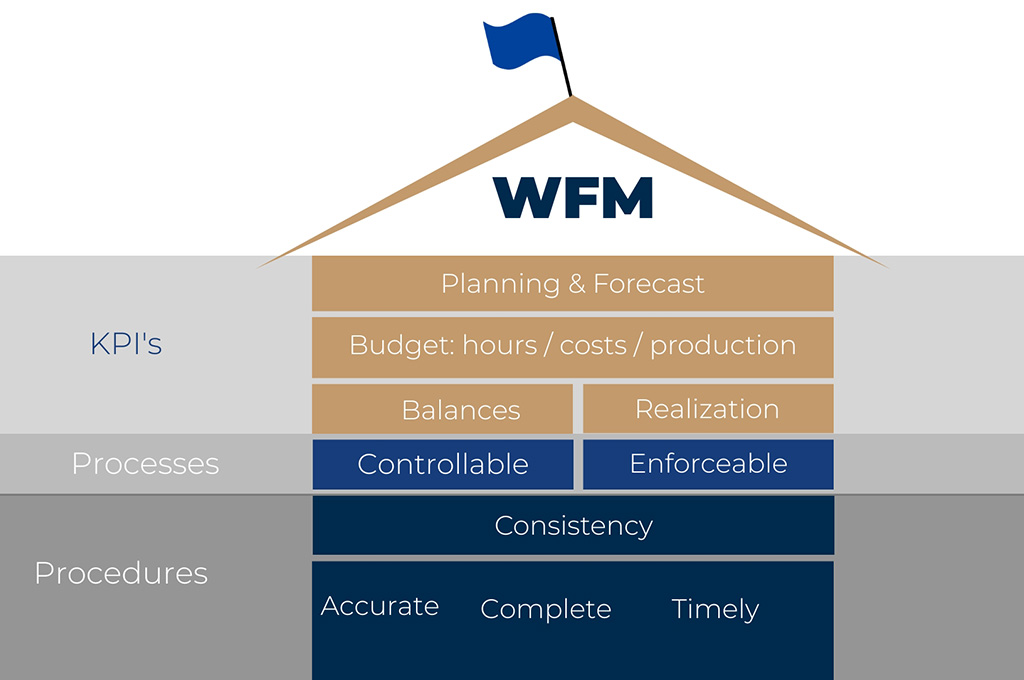Less Hassle in WFM with Management by Exception
HR teams in shift-based environments face constant pressure: rosters, hours worked and compliance need daily attention. But what if you only had to act on exceptions? With manage-by-exception, you focus on what really matters. In this article, we explain how better data, clear processes and smart WFM software can free up time for more strategic HR initiatives.
Manage-by-Exception in Workforce Management Software: How it Boosts Efficiency
Globally, around USD 5 trillion is lost each year to admin. As for Human Resources managers in shift-based workplaces, they’re fighting a constant battle. A battle to coordinate hundreds or thousands of frontline workers across retail stores, warehouses, factories, or call centers – and deal with endless schedules and attendance records in the process.
Manual HR processes force teams to spend hours on repetitive administrative tasks – checking who clocked in, checking if breaks were taken, and checking that scheduled and realized hours align – instead of focusing on strategic planning.
Research has shown that simply having technology in-place isn’t enough to overcome the endless stream of admin. For example, a survey from 2024 revealed that workers (in various roles) are wasting 12.6 hours per week on low- or no-value tasks. That was an increase compared to 2023 – despite increased investment in technology.
The best WFM software is about far more than basic attendance tracking and absence management. It minimizes huge volumes of unnecessary admin through a manage-by-exception approach. This article explores how.
The Challenges of Managing a High-Volume, Shift-Based Workforce
Employee Scheduling Complexities
Staff scheduling becomes extremely complex when you have to manage salaried and hourly workers across various shifts, locations, roles and contracts. Peak demand periods, shift swapping and last-minute changes add to the chaos.
Without robust workforce management tools, managers can end up guessing or constantly adjusting schedules, which is inefficient and can be a compliance risk.
Time and Attendance Data Overload
Every shift generates data on clock-ins, clock-outs, breaks, overtime hours, etc., and managers often have to go through all those records to find errors and correct them.
This is tedious and time-consuming, yet necessary to ensure payroll is accurate and labor laws are met. In a workplace with a high volume of shifts to manage, the amount of records makes manual review impractical.
Regulatory Compliance Pressures
Labor regulations add further complexity. And just one violation is a hassle that nobody wants to have to deal with – nor be blamed for.
Managing compliance across a large workforce means constantly checking for any exception that could breach policy; an overwhelming task when you aren’t using automation.
Administrative Burnout
All these repetitive tasks – building schedules, approving routine timesheets, responding to leave requests, fixing missed clock-ins – steal managers’ time.
Most organizations aspire to do more with less, but outdated, manual processes make it hard. Valuable hours that could go toward employee engagement or workforce planning strategy are instead spent checking endless records. This impacts productivity and morale. (In the study mentioned earlier, 41% of respondents were considering leaving their jobs due to the burden of repetitive tasks and the desire to abandon outdated ways of working.)
These challenges highlight the need for a more efficient way to manage the workforce, and this is where manage-by-exception comes in.
What Is Manage-by-Exception in Workforce Management Solutions?
Manage-by-exception is a strategy that focuses on identifying and handling cases that deviate from the norm.
In the context of workforce management, it means using WFM software to automatically handle routine, expected events, while alerting managers only to exceptions that fall outside predefined rules or standards.
Instead of micromanaging every detail, managers only need to focus on the exceptional issues that truly need attention.
Key Aspects of Manage-by-Exception in Workforce Planning Software
Automated Monitoring
The workforce management system is configured with the company’s policies and applicable labor laws. It automatically tracks all clocking data, attendance, and schedule adherence. Normal, in-bounds events simply get recorded with no manual oversight needed.
Exception Flags
Whenever something deviates – i.e., an employee clocks in late, misses a shift or exceeds their allowed hours – the system raises an alert. Managers get a notification highlighting those exceptions – and only them.
Managerial Action on Exceptions
Managers then focus their attention on these exceptions and take the necessary action. Their intervention isn’t required for everything that’s running normally.
In essence, the system does the watching and the manager does the problem-solving for the few cases that warrant it.
As well as saving time, this ensures that issues don’t go undetected, as the software is always handling compliance monitoring.
Manage-by-Exception and the WFM House
To gain the full benefits of manage-by-exception, you need solid, consistent processes. At MANUS, we use a framework called the WFM House to illustrate this.
The house represents a structured way of organizing labor management practices so that each area – such as time tracking or labor forecasting – is built on a reliable foundation. Only with such a foundation can organizations effectively improve their workforce management capabilities.
Consistency is the cement that runs through each layer of the house, holding it together.
Let’s explore the framework in more detail.
1. The Foundation: Accuracy, Timeliness and Completeness
The base of the WFM House is all about data quality (specifically in time registration). Three aspects to consider are:
- Accuracy: Are employees’ hours logged correctly? Do these records reflect the actual situation and are they in line with regulations and internal policy?
- Timeliness: Are time entries submitted promptly? Does the timing allow for steering and evaluation within a reasonable timeframe?
- Completeness: Has all the necessary data been recorded?
In MANUS WFM – our comprehensive workforce management solution – many different checks take place to ensure the above. However, these standards aren’t enough on their own; consistency is necessary to make sure they’re applied uniformly across every department, shift and location. Otherwise, one team’s data might not match another’s, and that makes reliable decision-making almost impossible.
This consistent, high-quality data is what makes manage-by-exception possible. When your foundation is solid, you can trust that anything the system flags as an exception is truly worth your time.
So how do you ensure consistency? This brings us to the next layer of the WFM House – controllable and enforceable processes.
2. The Lower Pillars: Controllable and Enforceable Processes
With a solid foundation, this next level of the WFM House is about ensuring that your processes are:
- Controllable: Managers must be able to monitor processes and make changes.
- Enforceable: Rules and standards must be clear and actually followed.
Manage-by-exception depends on this. If your workforce data isn’t collected in a standardized, enforceable way, then other errors that are not true deviations could be classed as exceptions. That just creates distraction. But when your processes are under control, you can focus on the real outliers.
3. The Higher Pillars: Balances and Realization
Above the pillars for controllable and enforceable processes are:
- Balances: Is there alignment between key factors such as time, cost and productivity?
- Realization: Are scheduled hours actually being worked?
Here, manage-by-exception ensures you don’t need to inspect every shift. However, you’d want to know if a particular store consistently shows significant gaps between scheduled and worked hours; thanks to the software’s reporting capabilities, these targeted, actionable insights are available.
4. The Roof: Planning, Forecasting and Budgeting
At the top of the WFM House are the strategic goals: planning, forecasting and budgeting. Improvement in these areas relies on everything below being in good order. After all, how could you forecast staffing needs and optimize labor costs without accurate historical data?
MANUS WFM can generate many different reports at each level of the WFM House, helping users maintain consistent processes and start optimizing.
More Benefits of Manage-by-Exception
Here are some more advantages to gain from enterprise workforce management software that uses this approach.
Faster Response and Resolution
Since only exceptions are flagged, issues can be dealt with promptly. For example, if someone forgot to clock out, the manager can correct it before it affects payroll.
Error Reduction
Automating standard processes (like approving perfectly accurate clocked hours) means things are done the same way every time. This reduces human error and helps ensure compliance.
Allowing Managers to Focus on High-Value Tasks
With the routine stuff handled, managers can redirect their attention to areas that bring added value – such as enhancing workforce planning strategy, employee engagement or performance management.
Conclusion
Configuring workforce management software with your organization’s rules and letting it filter out the routine from the urgent means your teams are always working on the highest-impact issues.
The payoff is greater operational efficiency, fewer errors, better compliance, and a management team that can dedicate time to building a better workplace.
To learn more about how MANUS WFM makes this possible, contact us today to request a demo.
By separating routine from urgency, your team can focus on what really counts. MANUS WFM enables this with automated alerts, smart control and consistent processes. Request a demo today.








